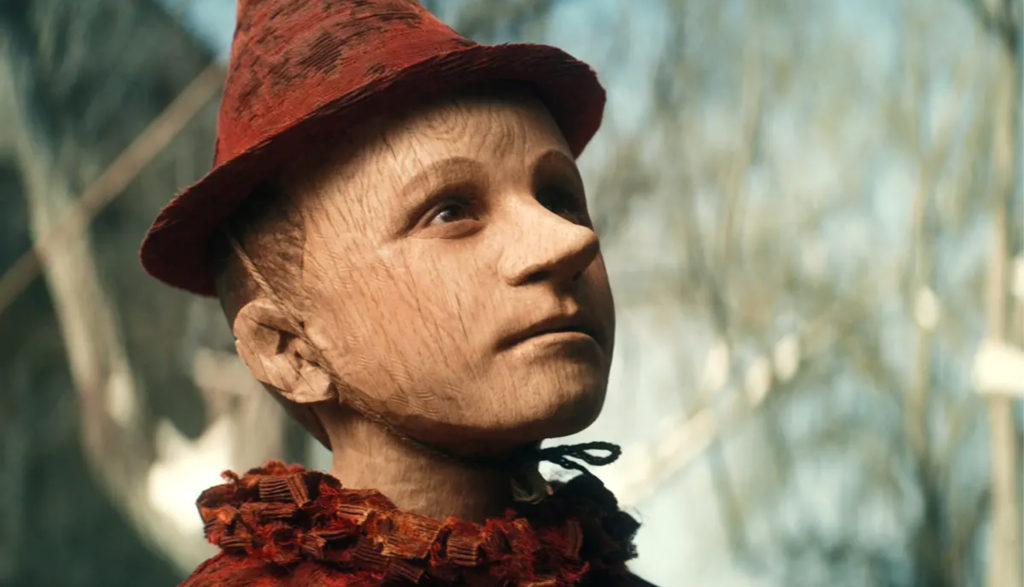
Everyone knows the story of Pinocchio. A poor carpenter longing for a child carves a wooden puppet in the shape of a young boy that is magically brought to life, and the puppet goes on a journey to learn responsibility and become a real boy.
Well, that’s not exactly the whole story—at least, not according to the original novel. And Italian director Matteo Garrone wants to make sure you know it.
While the 1940 Disney animated classic is undeniably the most famous version of this beloved tale, Carlo Collodi’s 1883 novel The Adventures of Pinocchio has spawned myriad adaptations. The most recent, Pinocchio, is a live-action Italian-language film (with English overdubs in the version reviewed here) that strips back the gloss of Disney’s classic in favor of a story much more faithful to its darker, grittier source material.
Pinocchio follows the titular puppet as the carpenter Geppetto carves him out of a piece of magical wood and adopts him as his son. Watching over Pinocchio as he gets used to his new surroundings is the Talking Cricket, who dispenses numerous pearls of wisdom that Pinocchio refuses to follow, and a Fairy, who guides him as he suffers the consequences of his poor decisions.
And many, many poor decisions there are. The Adventures of Pinocchio was originally intended as a cautionary tale for young children about the dangers of disobeying their parents, a theme which carries through to Garrone’s adaptation. When Geppetto takes his new son to school, Pinocchio sneaks across the street to a puppet show instead and is kidnapped by the owner, who’s looking to add some new performers to his collection. So begins Pinocchio’s long journey back to his village and to Geppetto, amidst constant setbacks due to his irresponsibility and bad decisions.
The story may sound familiar, but don’t let that fool you—this version of the classic tale is much more Grimms’ Fairy Tales than it is Disney.
Whenever Pinocchio makes a bad choice, he always suffers the consequences for it. He skips school to go to a puppet show, gets kidnapped by the ringleader and is taken far away from home; he gives his coins to two very sketchy strangers who claim they can magically multiply it, and those coins are predictably stolen. Poor Pinocchio, it seems, is something of slow learner. It’s only when the puppet starts to work hard and obey Geppetto that his constant troubles come to an end. Pinocchio’s central theme, then, emphasizes the importance of take responsibility and of telling the truth.
Fatherly love is a constant theme throughout the story as well; Geppetto is driven by his love for Pinocchio, going so far as to sell his jacket and waistcoat just to buy his boy a spelling book for school. When Pinocchio goes missing, Geppetto vows to search every corner of the earth to bring him home.
The Fairy who watches over Pinocchio also has a strong affection for him, though she’s definitely willing to discipline him when he disobeys or acts irresponsibly. Still, she always forgives him, welcoming him back into her home whenever he strays away. No matter how many times he makes mistakes, Pinocchio is never too far from redemption.
Like most fairy tales, a large part of Pinocchio centers around magic—he is a talking puppet, after all. The Fairy uses it regularly to help him out of sticky situations, and eventually uses it to turn him into a human boy.
Pinocchio and his friend Lucignolo are also magically turned into donkeys after they skip school to visit the “Land of Toys.” A host of other children are coaxed into that fate as well by an unscrupulous magician.
As for the story’s magic, it’s never explained. Magic plays a significant role in the narrative, but it’s accepted as a natural part of the world; barely anyone gives Pinocchio a second glance, despite him not really looking all that human. We also meet other magical characters and creatures, including the Snail Lady and a talking tuna.
In the puppet show that Pinocchio sneaks off to watch, the puppets go to “hell” and meet a puppet that plays the Devil.
None, except for some kissing on the cheek in a cultural Italian greeting.
It’s here that the biggest divide between the Disney story we all know and Garrone’s film lies. This version of Pinocchio features content that’s more disturbing than its animated counterpart. For example, Pinocchio is almost burned alive so the leader of the puppet show can cook his dinner. He’s turned into a donkey and thrown into the ocean with a weight around his neck. Perhaps most startling, he’s hung by his neck from a tree by two vagabonds who wait for him to die in order to steal his money.
Pinocchio’s teacher gleefully whips his students on the hand with a stick when they miss a question. After being turned into a donkey (another scene that’s not necessarily violent, but definitely disturbing, as we see Pinocchio and Lucignolo screaming for someone to help them), he’s sold to a circus leader who forces him to jump through a ring of fire. He makes it a few times before falling and apparently breaking his legs; the circus ringleader then ties a rock to his neck and throws him into the ocean before the Fairy turns him back into a puppet. Elsewhere, Pinocchio falls asleep with his feet in the fire, and his feet are burnt to stumps. He also hits the Talking Cricket on the head with a hammer. A young boy shows Pinocchio a scar on his head from where a store owner hit him after catching him stealing.
All in all, while bloody imagery isn’t necessarily an issue here, dark and disturbing content turns up regularly throughout the story. Various scenarios that took place in the animated version are much more realized in live action, and therefore more frightening when they take place upon a young boy rather than a cartoon. Pinocchio constantly finds himself (usually due to his own selfishness and disobedience) in perilous and terrifying situations—and unlike in Disney’s version, these perilous moments aren’t sugarcoated for a young audience.
God’s name is used in vain once. During the puppet show, a puppet cries out, “What the devil?!” Pinocchio also yells at the Talking Cricket, telling him to “shut up.”
Geppetto asks if the carpenter Ciliaga has been drinking, while another character accuses Geppetto of being drunk after he claims his puppet came to life. The Fairy gives Pinocchio bitter-tasting medicine to help him recover from his sickness.
Pinocchio goes to a judge (who just happens to be a gorilla) to report the theft of his money, and the judge bizarrely claims that anyone who is innocent must go to prison. To get out of going to jail, Pinocchio claims he’s a thief who stole a swine, a chicken and some jewels; the gorilla judge laughs and congratulates him for it.
Pinocchio is helped along his journey by other anthropomorphic animals, some of which look eerie and unsettling. Some of the most notable include a giant snail, who looks strange at best, frightening at worst. As for the Talking Cricket, he’s much more like a nightmarish alien than he is the Jiminy Cricket we all know and love.
Pinocchio is a hard nut to crack. Obviously, the original story was meant for children, and it possesses themes that are more than relevant for any child. “Woe betide the children who disobey their parents,” the Talking Cricket says. “They will never get very far in the world.”
And yet, in terms of content, Pinocchio feels much less suitable for the young audience it’s ostensibly trying to reach. From its dark and grisly tone to some borderline terror-inducing scenarios, the film’s more unsettling moments could result in nightmares for younger kids. Sensitive children watching will be far too busy hiding under the covers to listen to the film’s words of wisdom.
Director Matteo Garrone said of the film, “[It] was created to appeal to children, but we tried to imagine it so that it would reach everyone, children and adults.” Some older children might potentially enjoy Garrone’s more mature take on the story. However, when it comes to teaching younger ones about the importance of responsibility and smart decisions, parents may want to stick with Walt Disney until their kids are old enough to appreciate Garrone’s bold creativity.


Lauren Cook is serving as a 2021 summer intern for the Parenting and Youth department at Focus on the Family. She is studying film and screenwriting at the University of North Carolina School of the Arts. You can get her talking for hours about anything from Star Wars to her family to how Inception was the best movie of the 2010s. But more than anything, she’s passionate about showing how every form of art in some way reflects the Gospel. Coffee is a close second.